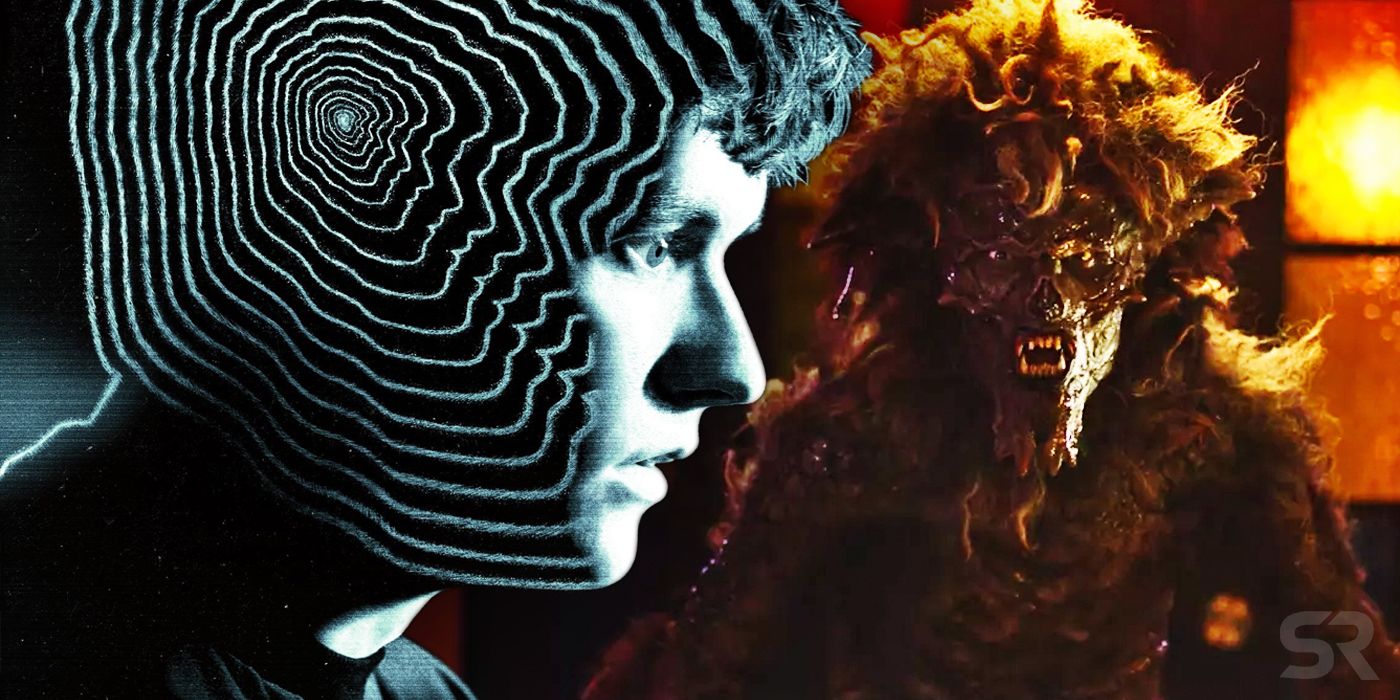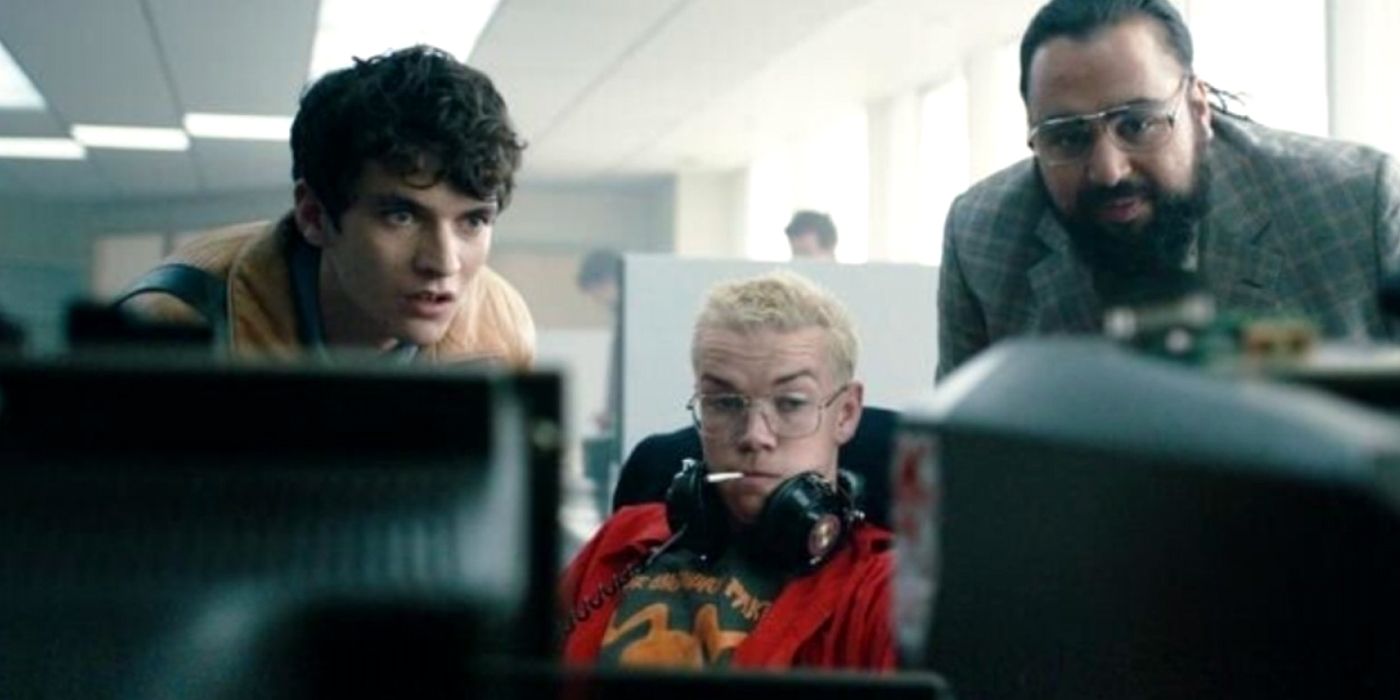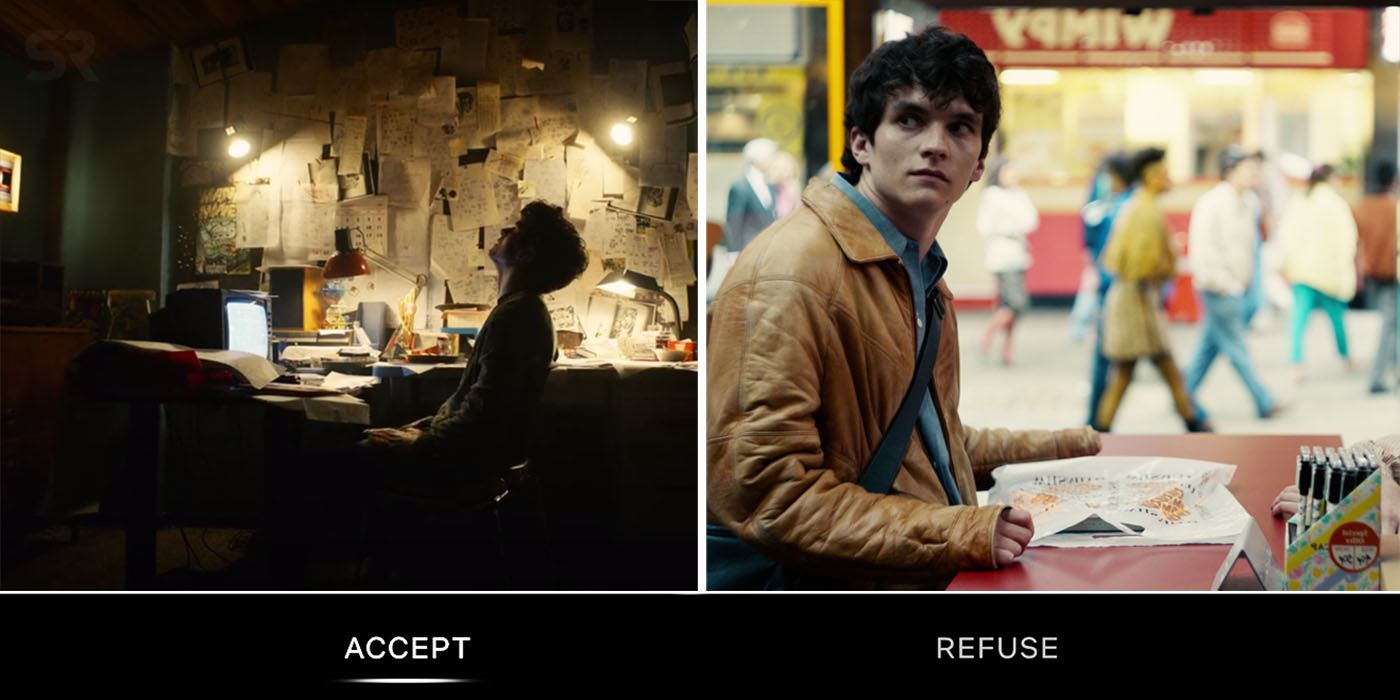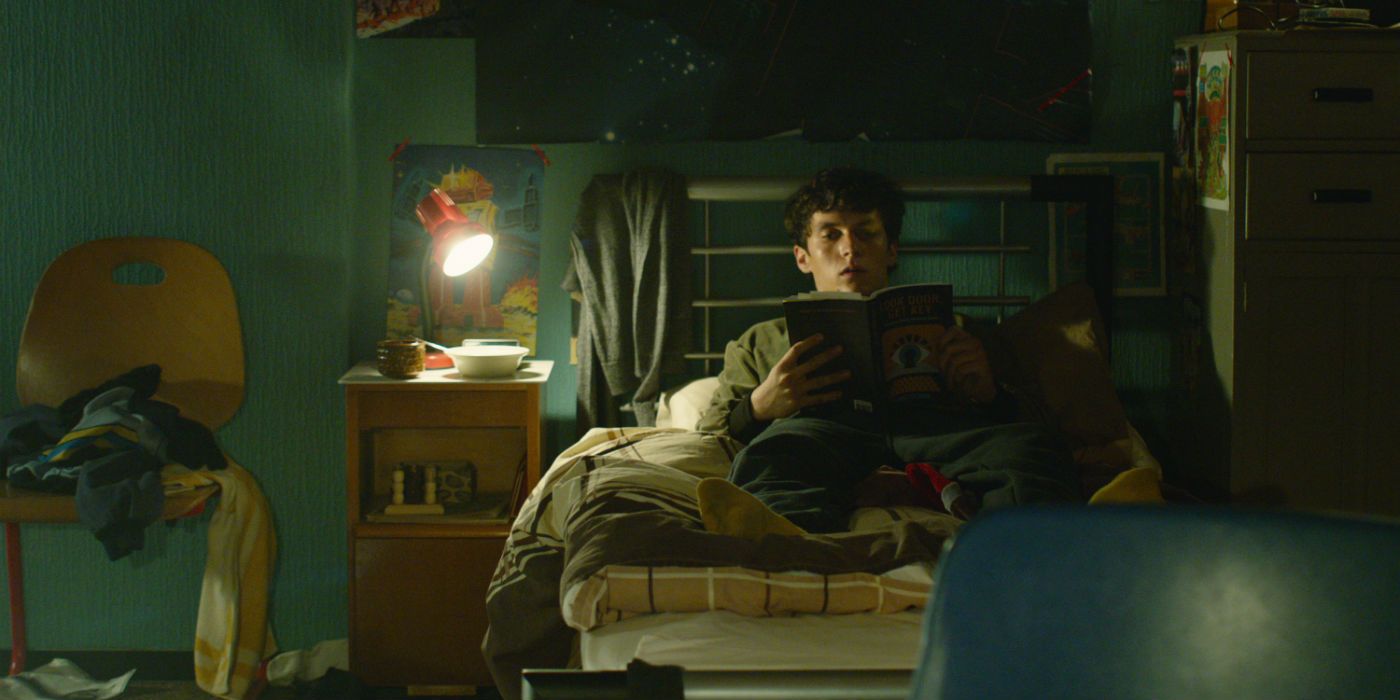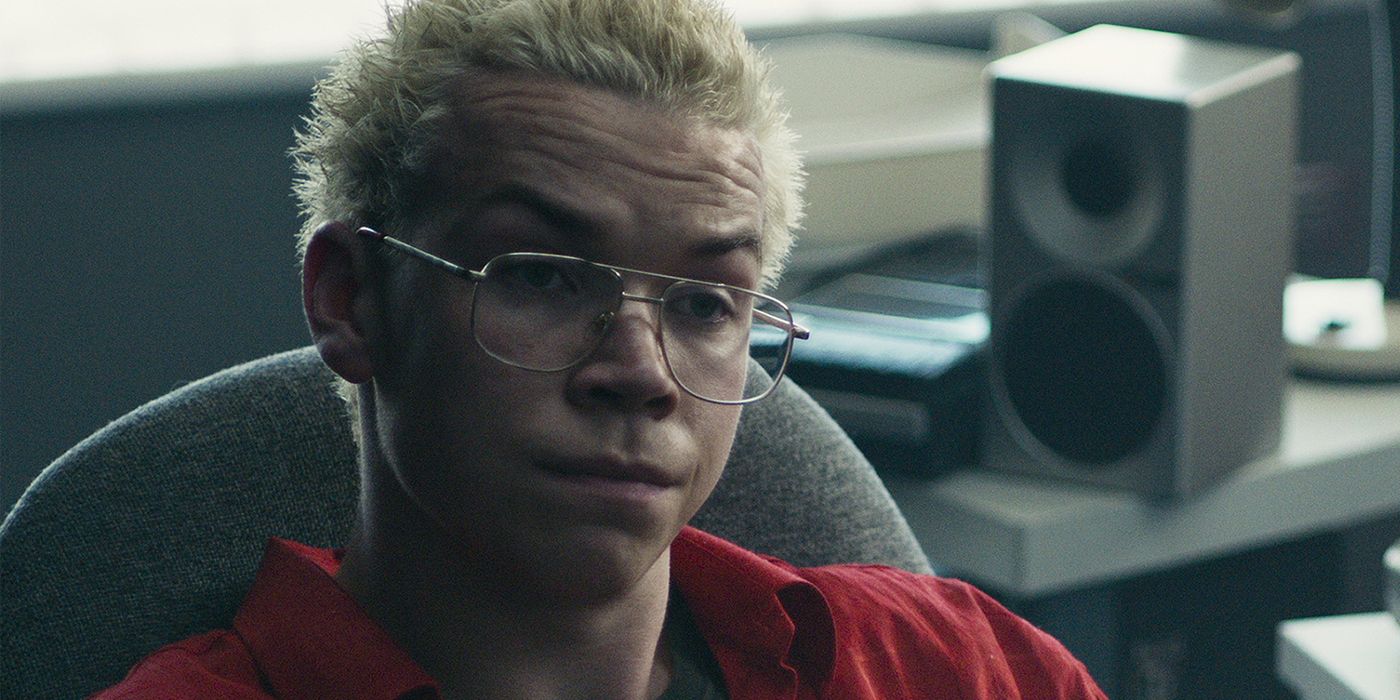Here's how to get the best ending in Black Mirror: Bandersnatch (although that may not actually be a good thing). The Netflix anthology series has always probed our reliance on technology, but this standalone movie takes it to a new level. Bandersnatch is a choose-your-own-adventure story in the spirit of horror and fantasy novels. On the face of it, Black Mirror: Bandersnatch tells the story of young game designer Stefan who's developing an interactive adventure based on his favorite fantasy book. Except he's not in control himself - the viewer is. As Stefan works on the game, viewers make all his key decisions, and he begins to suspect something is wrong.
The results are interchangeably hilarious, violent, and twisted. As with any game that involves choices, there's always an overbearing fear of making the wrong choice. Bandersnatch creates a sense of unease in deciding whether to eat Sugar Puffs or Frosties, but as it goes on, the narrative spirals in increasingly unpredictable ways - and back on itself. Just what are viewers supposed to choose? Using Netflix's own plan as a guide, though, here's the optimal route. Unfortunately, anyone who embraced the game's mantra of free will might be in for a rather rude surprise.
Black Mirror: Bandersnatch Has Five Endings, None Of Which Is Final
Black Mirror: Bandersnatch reportedly has one trillion unique story permutations (via BBC), a massive number on its own but incredibly sensible mathematically. If each choice creates a new plot thread, the number of different narratives increases to the power of two each time: two after one option, four after two, eight after three, sixteen after four, etc. By the time there are 40 choice points, that equals 2^40 = 1.0995116 trillion. Despite this, Black Mirror: Bandersnatch only has five distinct endings. The journey to get there, who dies, and how demented Stefan gets varies depending on choices, but at the end of the day, there is one of each.
For completion, these endings are: the entire episode is a TV show (jump out of psychiatrist's window); Stefan ends up in jail (kill Dad and bury him); a Netflix developer continues the game in the modern day (kill Dad and chop his body up); Stefan dies with his mother (open the safe in the dream and find a rabbit); Stefan is part of a scientific experiment (open the safe and find files). The specifics of each of these and how to get to them can be found in this explainer of the Black Mirror: Bandersnatch endings, but what's important is that none is the "best."
That's not to say the endings aren't good. Indeed, one of Bandersnatch's best aspects is how its early setup establishes ideas for vastly different conclusions; Stefan is in a TV show or Stefan is Donnie Darko go hand in hand. But with all endings, except one, leading to the destruction of Stefan's life by death or incarceration (and that exception essentially being a joke), it's clear a single optimum can't exist. That's why, upon completion of one Black Mirror: Bandersnatch ending, Netflix takes the viewer back to a point where the choices diverged, enabling a person to take a different path and get a new ending.
The credits only roll unimpeded after the viewer attained all five Black Mirror: Bandersnatch endings in some form. There really isn't a "best" ending to Black Mirror: Bandersnatch because the real ending is all of them together. There's surely an optimum, although given the number of parameters to get all that's within a small range. The best then becomes about ideal order. And, thankfully, that's something Netflix has confirmed.
Netflix's Best Way To Play Black Mirror: Bandersnatch
Everything so far has been working off the assumption that viewers watch Black Mirror: Bandersnatch as intended, making choices at every step of the way. If they don't, however, the experience is subtly different. Not picking an option means that, once the timer has run out, Netflix selects the outcome. The story is the same, but the player's direct influence is gone.
Following this method through to the very end of the game, this is the order of events:
- Sugar Puffs or Frosties
- Thompson Twins or Now 2
- Accept or Refuse (reset)
- Accept or Refuse
- Talk About Mother: Yes or No
- Phaedra or The Bermuda Triangle
- Throw tea over computer or Shout at Dad (reset)
- Follow Colin or Visit Dr. Haynes
- Bite nails or Pull earlobe
- Throw pills away or Take them (reset)
- Throw pills away or Take them
- Destroy computer or Hit desk (reset)
- Destroy computer or Hit desk
- Pick up family photo or Pick up book
- Throw tea on computer or Destroy computer
- Netflix or Glyph
- Yes and F**k Yeah
- Leap through the window or Fight her (TV Show Ending)
- Follow Colin or Visit Dr. Haynes
- Drugs: Yes or No
- Stefan or Colin (reset)
- Stefan or Colin
- Pick up family photo or Pick up book
- Netflix or Glyph
- Kill Dad or Back Off
- Bury body or Chop up body
- Game complete: Yes or No
- Where Is Colin: No idea or He jumped (Jail Ending)
- Bury body or Chop up body
- Throw tea on computer or Destroy computer (Modern Day Ending)
- Get Rabbit from Dad (no choice reset)
- Pick up family photo or Pick up book
- TOY or PAC
- Go with Mum: Yes and No (Train Ending)
- Program and Control (no choice reset)
- Pick up family photo or Pick up book
- PAX or PAC
- P.A.C.S. or Glyph
- Phone number not entered (P.A.C.S. Ending)
In short, the game takes you automatically through all five endings - TV Show, Jail, Modern Day, Train, and P.A.C.S. - in 39 steps. It's worth noting that at the very end of this track, there is a point that almost forces the player to interact: when calling Dr. Haynes after killing his father in the P.A.C.S. ending, Stefan won't insert the correct numbers (2-0-5-4-1) without outside input. However, this only leads to one short scene and doesn't alter the actual ending (which is a variation on the Jail ending).
This appears to be standard across Netflix accounts, suggesting that rather than a freewheeling playthrough, it's the default, suggested order for Black Mirror: Bandersnatch. That would make sense given how the story is told; it introduces core ideas as early as possible - the game's bad review after first choosing "Accept" doesn't just introduce the fail-skip feature but establishes the learning timelines, while the order takes the "Follow Colin" choice as early as possible (thus opening up the idea of a broken world) - and completes various areas before moving to the others.
This means that it is as close to the optimum way to play the game that exists. As such, for anyone looking for the best ending to Black Mirror: Bandersnatch, it would be best to follow this route to get the most out of the game in a suitable timeframe. However, that would, of course, mean they are essentially following a pre-determined track in a game built on free will - and that may be the entire point of Black Mirror: Bandersnatch.
The Best Ending Reveals Black Mirror: Bandersnatch's Dark Twist
The underlying theme connecting all episodes of Black Mirror is the focus on how technology impacts lives in subtle yet insurmountable ways. This can be the Twitter mob making the Prime Minister of the United Kingdom have relations with a pig on live TV, a cartoon character meme becoming a politician, or love transplanted into a computer farm. Black Mirror: Bandersnatch brings this in spades, using the freedom given to the viewer to explore the impact it has on a no-longer-autonomous character and the very nature of free will. This is a story made for the form.
But the method of the form itself is the story. Just as the season 4 finale "Black Museum" brought together ideas from across the show in microcosm (playing with the long-held fan theory of a Black Mirror shared universe), Bandersnatch's use of choice impacts the viewer. The agony over which cereal to eat at the start or the quick response to killing Stefan's father, everything that happens is about the reverse impact on the player and not the character. This is compounded by how each ending is incompatible with the others (Stefan can't be part of P.A.C.S. and a TV show); the choices rewrite the fabric of this reality.
And this is where the optimum story order comes in. If the best ending of Black Mirror: Bandersnatch is the one that Netflix pre-programs, then there is limited freedom in the choices made in the game: it is best following what the streaming service suggests, just as Stefan is following the viewer's "commands." This is true no matter which way a person plays the game. It only ends when every ending occurs, exhausting the narrative. The one true ending is exactly the same and inevitable, a meticulously planned experience. Charlie Brooker gave viewers unprecedented freedom to tell a story where the long-term impact was already predetermined.
Black Mirror: Bandersnatch is ultimately about the illusion of free will, presented not just by the character in his story but in how the viewer makes choices when the end goal is unchangeable. That's the only real ending. And certainly, the best way to get it is to give that sense of autonomy back to Netflix.
Will They Ever Make A Bandersnatch Sequel?
The multiple endings of Black Mirror: Bandersnatch didn't leave much room for more story. Stefan either ended up dead, in prison, or in a game himself. With that said, there are some ways that a Bandersnatch sequel could possibly happen. The biggest way this could happen is by just ignoring the Bandersnatch story and just making something along the same lines. Even if it takes place in the same universe, a Bandersnatch sequel could move on without worrying about Stefan at all, or even just mentioning him as an aside as either someone who killed his father, or his actual appearance in a game if that ending was the real one.
There is also a chance that Black Mirror could do a sequel by just making another choose-your-own-adventure movie, although these are not easy. Bandersnatch was the same amount of work as multiple regular episodes, so it would have to come as another solo release. Even Black Mirror creator Charlie Brooker said it was possible. "Annabel and I both said at various points, 'We’re not doing this ever again.' But like someone who has gone through the horror of childbirth and has forgotten about it in time to conceive again, I started thinking, 'Oh, there’s an idea! You could do this, or you could do that."
Will Poulter also came up with ideas on how he could return for a Bandersnatch sequel, saying he could possibly be a time traveler who could one day reappear in Stefan's life. "I would love it if [Colin] showed up in full-on, ’80s regalia, but he was, in fact, in the present day, or somewhere in the future. That would be really fun." Even if there is never another Black Mirror: Bandersnatch-style episode of the series, the original will likely stand the test of time as an original idea, and one that other shows tried to copy after the fact, most of which to a less success.

